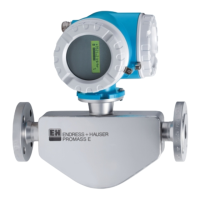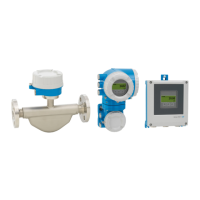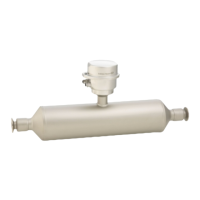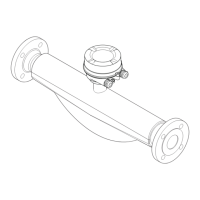Promass 40 9 Trouble-shooting
Endress+Hauser 39
9.3 Process error messages
Type Error message / No. Cause Remedy
Process errors can be defined as either “Fault” or “Information” messages and can thereby be weighted
differently. Determination of this is done via the function matrix (see the “Description of Device Functions”
Manual). The error types listed in the following correspond to the factory settings.
Also observe the information on
→ Page 26 ff. and 42
P = Process error
= Fault message (with an effect on the inputs and outputs)
! = Information message (without an effect on the inputs and outputs)
P
OSC. AMP. LIMIT
# 586
The fluid properties do not allow a
continuation of the measurement.
Causes:
– Extremely high viscosity
– Process fluid is very inhomoge-
neous (gas or solid content)
Change or improve process
conditions.
P
TUBE NOT OSC
# 587
Extreme process conditions exist.
The measuring system can there-
fore not be started.
Change or improve process
conditions.
P
NOISE LIMIT
# 588
Overdriving of the internal analog
to digital converter.
Causes:
– Cavitation
– Extreme pressure pulses
– High gas flow velocity
A continuation of the measure-
ment is no longer possible!
Change or improve process condi-
tions, e.g. by reducing the flow
velocity.
P
!
EMPTY PIPE
# 700
The process fluid density is below
the lower limit value set in the
“EPD” function.
Causes:
– Air in the measuring tube
– Partly filled measuring tube
1. Ensure that there is no gas
content in the process liquid.
2. Adapt the values in the “EPD”
function to the current process
conditions.
P
!
EXC. CURR. LIM
# 701
The maximum current value for
the measuring tube exciter coils
has been reached, since certain
process fluid characteristics are
extreme, e.g. high gas or solid
content.
The instrument continues to work
correctly.
In particular with outgassing fluids
and/or increased gas content, the
following measures are recom-
mended to increase system
pressure:
1. Install the device at the outlet
side of a pump.
2. Install the device at the lowest
point of an ascending pipeline.
3. Install a flow restriction, e.g.
reducer or orifice, downstream
from the instrument.

